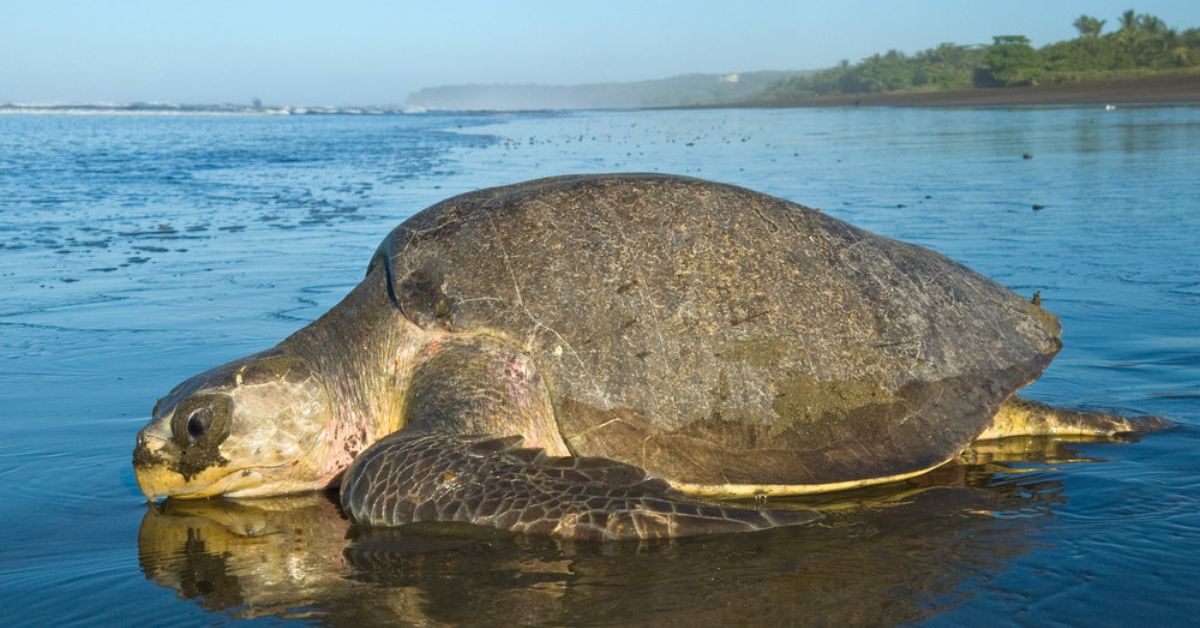How a Quiet Morning Walk Turned a Man from Goa Into a Hero for Olive Ridley Turtles
On an early morning walk along Goa’s Vagator Beach, local resident Tukaram Palyekar noticed two olive ridley turtles trapped in fishing nets. Instead of walking on, he stepped in to help, carefully freeing them and carrying each tired turtle back into the sea.
The rescue began near the rocks, where fishing nets, likely lost or discarded, had ensnared the turtles’ flippers. “He gently cut the nets away,” reported local media. Once freed, the exhausted reptiles couldn’t make it back on their own. Tukaram lifted the first turtle — estimated around 20–25 kilograms — and carried it to the water’s edge. He repeated the effort for the second time.
Photos published by The Goan Network show Tukaram supporting a turtle against his chest, wading into the surf until the animal could swim off under its own strength.
His actions highlight how even a single person can make a tangible difference for wildlife caught amid human activity.
What are Olive Ridley Turtles?
Olive Ridleys (Lepidochelys olivacea) are the smallest sea turtles and the most numerous worldwide, but that doesn’t make them any less vulnerable.
- Appearance: Named for their olive-green shell, they’re compact and heart-shaped.
- Diet: They feed on sea urchins, jellyfish, crustaceans, and sometimes algae.
- Distribution: They swim across tropical and subtropical waters of the Pacific, Atlantic, and Indian Oceans.
Odisha’s epic Arribadas (mass nestings)
Olive Ridleys are famed for Arribadas, mass nesting events in which hundreds of thousands of females return simultaneously to lay eggs on beaches. These synchronized gatherings occur primarily on Odisha’s coast, at:
- Gahirmatha, the world’s largest nesting site
In 2025, Odisha recorded over one and a half million nesting turtles — about 600,000 at Gahirmatha and 900,000 at Rushikulya..
IFS (Indian Forest Service) officer Susanta Nanda captured and shared the excitement: “Happy to inform that one of the most spectacular natural events — the arribada — has started at Gahirmatha coast… Annual mass nesting of lakhs of female Olive Ridleys is breathtaking. Staff are all geared up to give them the best possible protection.”
He also highlighted how both sites were active simultaneously: “Odisha is witnessing a rare phenomenon of mass nesting at both, Gahirmatha & Rushikulya rookery simultaneously.”
The perils these turtles face
Despite these spectacular events, olive ridleys battle many dangers:
- Fishing gear entanglement, reported even at popular beaches like Chennai (over 400 dead washed ashore)
- Coastal pollution and development, sand erosion, and artificial lighting that disorient nesting turtles and emerging hatchlings.
- Climate change, which alters sand temperatures, a key factor in determining hatchling sex
Conservation efforts include relocating nests, setting up hatcheries, restricting fishing during nesting seasons, and installing turtle-friendly lighting.
Satellites are being used to map their journeys
Ocean journeys are being tracked, too. In 2025, one satellite-tagged ridley travelled over 1,000 km from Gahirmatha to Andhra Pradesh within 51 days. Another crossed 3,500 km to Maharashtra earlier in the year.
Between 2021 to 2023, over 12,000 turtles were fitted with flipper bands or satellite trackers. India aims to tag 100,000 more by 2031, mapping migration routes to aid protection efforts.
 In 2025, one satellite-tagged ridley travelled over 1,000 km from Gahirmatha to Andhra Pradesh within 51 days. (Representational picture source: Square Space)
In 2025, one satellite-tagged ridley travelled over 1,000 km from Gahirmatha to Andhra Pradesh within 51 days. (Representational picture source: Square Space)
Goa’s turtle awakening
Goa has become an unexpected nesting hotspot. Vagator saw 1,227 eggs laid across twelve nesting events in the first half of 2025 — a record for this beach.
The reduction of rave parties and loud nightlife is credited with creating a safer, quieter environment.. This encouraged turtles to nest peacefully.
In response, locals and environmentalists are urging authorities to designate Vagator an official turtle conservation site. Ramesh Naik from the Anjuna Biodiversity Management Committee argues that with proper protection, Vagator could become Goa’s next major nesting beach.
How can you join in
You don’t need to be a marine biologist to help:
- Visit beaches thoughtfully: Leave them cleaner than you arrived.
- Keep lights dim and music off during nesting season (November–May).
- Always report rescues to the forest or wildlife departments.
- Push for protection: Help Vagator – and any turtle beach – become a conservation area.
Tukaram’s rescue that morning wasn’t an assignment. It was a gesture. A nudge toward a better harmony between people and the sea.
Edited by Saumya Singh
News